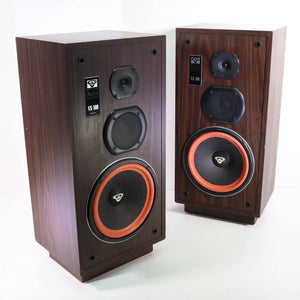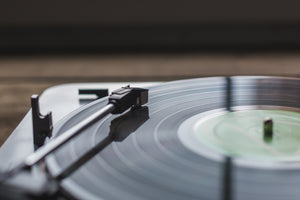We are unable to reply to comments, so please message us directly if you have a specific question regarding products, shipping costs, etc. Our office number is (480) 207-1511. Our email is hello@spencertified.com. You can also message us on Facebook. Commonly asked questions and answers can be found on our FAQs page here.

HOW TO CHOOSE THE RIGHT SPEAKER CABLE: 3 ESSENTIAL RULES
THESE 3 EASY GUIDELINES WILL HELP YOU PICK OUT SPEAKER WIRE LIKE A PRO
Receiver? Check. Speakers? Check and check. Then toss in a turntable, CD player, and maybe a cassette deck or two, and you’re ready to jump feet first into the world of audio, right?
Not quite. Whether you’re setting up a vintage stereo system or you’re going full home theater, you have one last job before it’s all complete: Choosing speaker wire. Speaker cable is the magic ingredient that can either make your hi-fi system dazzle – or totally flop.
Perfect for both beginners and those needing a refresher course, this simple three-rule guide will help you avoid the easiest mistakes to make when picking out wire. This way you can get your speakers sounding the best they possibly can.
WHY IS THIS IMPORTANT?

Speaker cables act as the vital link between your amplifier and speakers, delivering the power needed for your music to come alive. These cables are key to capturing every tiny detail in your tunes, so you can’t overlook their importance!
Cheap cables can mess with your sound by limiting dynamics, shrinking bandwidth, or tweaking volume and tone. Simply put, poor cables can dull your audio’s true colors and spoil the listening experience. You need to choose wisely to keep your music sounding its best.
RULE 1: KNOW BEFORE YOU BUY

Knowing what you’re buying before you buy sounds simple, but it’s an important one to keep in mind as you shop around. For example, some retailers use misleading stock images with connectors like banana plugs at the end, but if you take a look at the description, it’ll state that the plugs aren’t included and need to be purchased separately. And many will sell per foot, so be sure to enter the correct number of feet you need before hitting “Add to Cart.”
You might also need to purchase a couple of tools depending on the speaker route you go. With bare speaker wire, you’re going to need cable cutters and strippers. Particularly if it’s some decent cable, you don’t want to risk damaging it with your average kitchen knife.
RULE 2: NOT ALL CABLE IS CREATED EQUAL

Speaker wire is not universal. It varies by quality, brand, type, and size. For example, you can get speaker cable with connectors (like banana plugs or spade connectors) or without (bare wire); you can even purchase the bare wire and connectors separately in case you want to mix and match.
There are also different wire gauge options. The AWG (American Wire Gauge standard) is what you go by - the lower the number, the thicker the wire. Thicker wire (like 12- or 14-gauge) has less resistance to current flow, making it ideal for lower-impedance speakers (4- or 6-ohm), high-power loads, and longer runs. Thinner wire (such as 16-gauge) is better for shorter runs of 50 feet or less that go to standard 8-ohm speakers.
If you’re able to try different combinations in person at a retailer, that’s typically the best way to go. But that's not usually possible. So we recommend always reading both reviews and product descriptions so you can find a cable with characteristics that match your hardware. There’s the cost factor as well. Higher-end systems deserve higher-end cable. As a good rule of thumb, aim to spend about 10 to 15 percent of your audio system budget on the cables.
Pro Tip! If in doubt, check your product’s manual. Many speaker and receiver manuals will have a recommendation of which gauge and type is best for that particular system.
RULE 3: MEASURE, MEASURE, MEASURE

Last but not least, always measure before you buy! There’s nothing more annoying than researching and reviewing speaker cable, buying the perfect gauge and type for your setup…then realizing you’re a few feet short. That’s why it’s best to measure first! Most retailers sell cable and wire by the foot, but some offer cable as 50-ft or 100-ft spools, so be sure to check what length is being sold. You’ll also want the same length for the left and right channels to ensure equal impedance loads (thus preventing any negative impact on the sound).
Pro Tip! To get an accurate measurement, take a string and run it from your receiver’s terminals to the speaker locations. Measure the length of string, then add on a few extra feet for some slack and to give yourself some wiggle room in case you need to strip the cable end (in cases of bare cable). Remember: it's always better to overestimate than underestimate.
IN SUMMARY

Speaker cable is the pulse that keeps your audio system alive. It is the veins that connect your receiver to your speakers, and we’re not exaggerating when we say speaker wire makes all the difference between a hi-fi shine and a mediocre gleam. A few rookie mistakes and your audio setup can become a living nightmare.
But now that you’ve read our guide, you’re safe from the terrible realities of too-short speaker wire and buying what you believe to be 20 feet of cable complete with banana plugs only to find out it’s a single foot of bare wire….
Thanks for reading! Have a great day.



Leave a comment